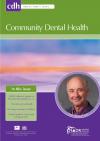Community Dental Health

- Cover Date:
- June 2016
- Print ISSN:
- 0265 539X
- Vol:
- 33
- Issue:
- 2
Caries and costs: an evaluation of a school-based fluoride varnish programme for adolescents in a Swedish region
In 2003, 19 public dental clinics in Västra Götaland Region implemented a population-based programme with fluoride varnish applications at school every six months, for all 12 to 15 year olds. In 2008, the programme was extended to include all 112 clinics in the region. Objective: To evaluate caries increment and to perform a cost analysis of the programme. Basic research design: A retrospective design with caries data for two birth cohorts extracted from dental records. Three groups of adolescents were compared. For Group 1 (n=3,132), born in 1993, the fluoride varnish programme started in 2003 and Group 2 (n=13,490), also born in 1993, had no fluoride varnish programme at school. These groups were compared with Group 3 (n=11,321), born in 1998, when the programme was implemented for all individuals. The total cost of the four-year programme was estimated at 400SEK (≈44€) per adolescent. Results: Caries prevalence and caries
increment in 15 year olds were signiï¬cantly lower after the implementation of the programme. Group 2, without a programme, had the highest caries increment. The cost analysis showed that it was a break-even between costs and gains due to prevented ï¬llings at the age of 15. Conclusions: This school-based fluoride varnish programme, implemented on a broad scale for all 12 to 15 year olds, contributed to a low caries increment at a low cost for the adolescents in the Västra Götaland Region in Sweden.
Key words: adolescent, caries prevalence, dental caries, fluoride varnish, prevention, school based prevention
doi:10.1922/CDH_3875Bergström07
- Article Price
- £15.00
- Institution Article Price
- £
- Page Start
- 138
- Page End
- 144
- Authors
- E-K. Bergström, P. Lingström, M. Hakeberg, L. Gahnberg, U.M. Sköld
Articles from this issue
- Title
- Pg. Start
- Pg. End
- Child oral health in migrant families: A cross-sectional study of caries in 1-4 year old children from migrant backgrounds residing in Melbourne, Australia
- 100
- 106
- Feasibility, utility and impact of a national dental epidemiological survey of three-year-old children in England 2013
- 116
- 120
- A bi-level intervention to improve oral hygiene of older and disabled adults in low-income housing: results of a pilot study
- 127
- 132
- Caries and costs: an evaluation of a school-based fluoride varnish programme for adolescents in a Swedish region
- 138
- 144
- Examiner reliability in fluorosis scoring: a comparison of photographic and clinical methods
- 145
- 150
- Do ‘poor areas’ get the services they deserve? The role of dental services in structural inequalities in oral health
- 164
- 167
